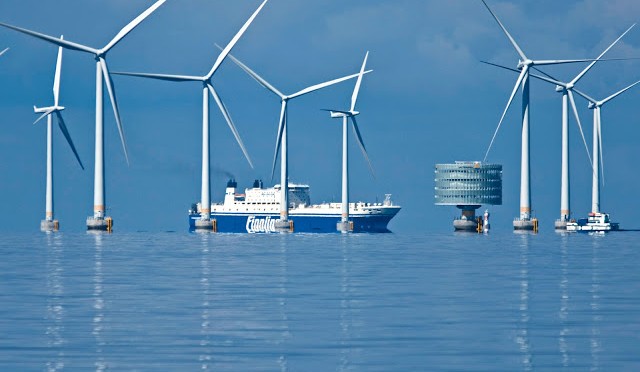Offshore wind capacity in the EU, according to a draft policy document, “should be multiplied by 25 times by 2050”, as the European Commission looks for all possible ways of boosting the share of renewables in energy consumption. Today, European offshore capacity stands at 23 gigawatts (GW). The leaked draft of the European Commission’s offshore renewable energy strategy, due to be presented on Thursday (19 November), wants the EU to reach 60 GW by 2030 and 300 GW by 2050. The North Sea, the Baltic, the Atlantic, the Mediterranean and the Black Sea all have potential for greater deployment of wind turbines, with the North Sea currently holding the world’s top spot for offshore wind. “The wind industry stands ready to deliver on the challenging and ambitious expansion targets. Wind is cheap and scalable,” says Ivan Pineda, director of public affairs at WindEurope, an industry group.
However, Pineda also said the industry needs a revamped policy framework to sustain this kind of growth. The offshore strategy is being discreetly pushed by Germany, which currently holds the rotating EU Council presidency and has the biggest stake in the market after it started boosting its stalled wind market with a new offshore plan in 2019. Germany currently hosts two dozen offshore wind farms, located in the North Sea and Baltic Sea off the country’s coast. And although new turbines are added every year, the expansion has tended to slow down: whereas 1,800 offshore wind turbines were connected to the grid in 2017, only 1,400 new ones were added by 2020. By 2030, 65% of Germany’s electricity needs are to be covered by renewable energies, but in 2019, that share was stuck at 42%. A key factor to unlock offshore wind is to build the necessary infrastructure on land, because the electricity produced off the coast must be fed into the power grid onshore. Experts say that even though Germany is well positioned compared to other EU countries in terms of offshore electricity production, there is still a lack of transmission grids onshore.
In France, from Dunkirk to Noirmoutier, the whole coastline should welcome seven new offshore projects between 2022 and 2027 with a capacity of 3.5 gigawatts. The building of these wind farms was authorised after the French state made calls for tenders in 2011, 2013 and 2016. The French industrial branch of offshore wind energy is one of the most competitive – of the twelve European factories that produce offshore wind turbines, four are in France. Still, France does not currently have any active wind farms, while the UK has nearly 2,225 wind turbines in operation, accounting for 45% of European installations on its soil, followed by Germany (34%) and Denmark (8%). This is also why the Commission‘s offshore renewable energy stratégy foresees member states working across borders to scale up offshore wind. However, legislation for these hybrid sites is still in its infancy and investment is difficult because of complicated cross-country negotiations.
The strategy also comes as the Commission looks to increase the EU’s renewables target up to 38-40% of the bloc’s energy consumption – roughly double today’s share – in order to meet the bloc’s updated 2030 climate goals. “The Commission estimates that an installed capacity of 300 GW of offshore wind, and around 60 GW of ocean energies, by 2050 would be needed in the integrated, greener and climate neutral energy system of 2050,” the draft document says. The draft EU strategy also aims to address the whole value chain of offshore wind, including part manufacturing and the development of port infrastructure onshore. In terms of technology, the EU strategy sees a scale-up in both classic fixed-bottom turbines and newer floating turbines which are now coming to the market. Floating turbines enable wind farms to be installed in deeper waters, because they are not immediately fixed to the seabed. They are a new technology compared to fixed-bottom turbines, with the first site opening in Scotland in 2017 and the second in Portugal in 2019. The continuation of research and development into floating wind technology is acknowledged in the draft strategy, but the industry is calling for scale-up finance for larger demonstration projects to further reduce the cost of the technology.




